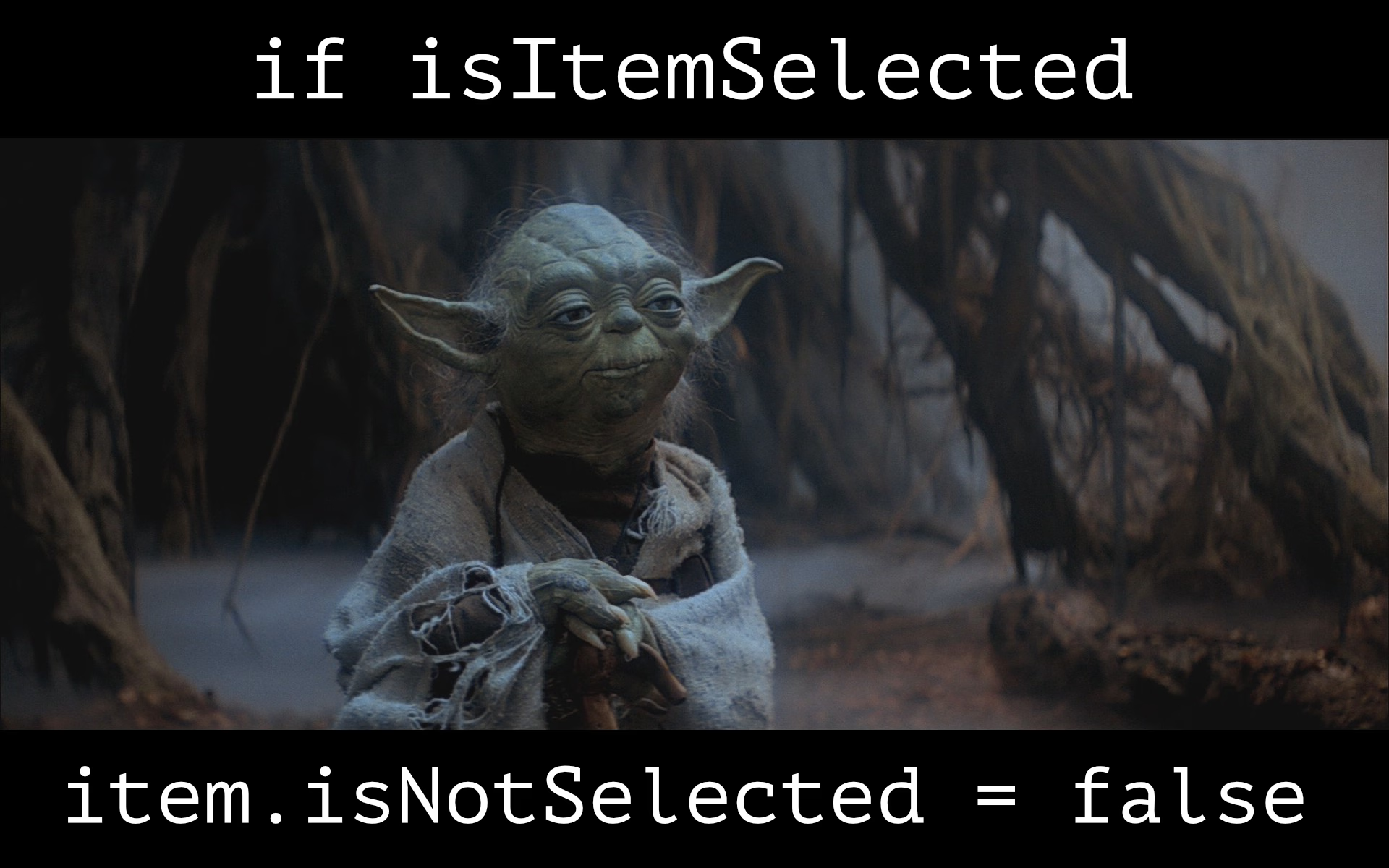Working in a team environment requires effective communication. It’s the reason why in a team we all work on the same project, in the same office, and speak the same language.
We need to have common vernacular to be able to communicate effectively with others. Writing code the same way that we speak will improve how our code is communicated and understood.
Do you ever completely lose your mind whilst reading someone else’s code? Maybe you go bananas over code you wrote last week?
In this article, I have outlined some tried and tested naming conventions that will increase code readability and raise your dev team’s performance.
All examples are written in pseudoscript. You can apply them to any language.
“Programming is the art of telling another human what one wants the computer to do.”
- Donald Knuth
Write for clarity
Consider the variable openModal.
Without any context, what do you think this variable describes?
When coming across it in the code, a developer could naturally assume that openModal is a function, with the purpose to open a modal. This is a reasonable assumption, because functions are generally thought of as commands.
Deciding to store the modal’s identifier in this variable would be confusing. If the intention of the code was to be an identifier then we should have named it something more explicit, for example currentModalId.
If you thought openModal was a good name for your boolean value, guess again; modalIsOpen is much more explicit for a boolean as it describes the current state of the modal.
Maybe we should use the English language itself to help us name our variables! Think about how a variable sounds within the code it’s used in. if modal is open sounds way more natural than if open modal or if is modal open. I am sure that our little green Jedi would be impressed. However, your fellow humans would prefer you to communicate your intention more clearly.
Here I have provided examples that don’t require much guesswork or assumption. The basis for all of these examples is to write your code so that it reads how you would speak. If possible, follow the approach of naming your functions and variables so that when taken out of context, a fellow developer will understand its purpose.
You shouldn’t have to read through multiple lines of code and memorize several other identifiers to understand what a specific variable represents.
Sure, in many development environments you can jump to the declaration through a shortcut, or hover over the variable to find its type. But, you shouldn’t have to do this. Treat your code as a product, and create a nice experience for the users (fellow developers) of your code.
If we have the power to name things whatever we want, why not name things with purpose and precision?
Tip
When naming variables, sometimes it can help to speak the name out loud in the context of other code.
Okay, let’s name our variables clearly for humans to read!

Naming Conventions
Functions
When you write a function, you are literally talking to a computer. Either you are telling the computer to do something a command, or you are asking the computer a question. So when writing your functions, name them so that our fellow humans can understand the intention and meaning behind the function. Name them as a command or a question!
For example, let’s say we want to know the total price of all items in a shopping cart.
var totalPrice = getTotalPrice(cartItems)
How about checking to see if all cartItems are in stock?
var allCartItemsAreInStock = areAllCartItemsInStock()
Do it now!
There is an important difference between something’s state right now vs where it should be. This can be difficult for devs coming from a non-english speaking background. It works like this, when something should have a specific state, we are expressing that there is a set of rules that enforce this state, otherwise we are describing the state now without any rules or conditions.
What is that? Do this!
Here are three functions:
disableButton(buttonId);
isButtonDisabled(buttonId);
shouldButtonBeDisabled(buttonId);
Please take a moment and think about what each of the functions is for. How do you think it would be used without having prior knowledge of its context?
Each of these functions means something very specific, just by reading the name a developer should know exactly what the expected output and behaviour is.
Disabling a button when a condition is met.
/**
* @param {string} buttonId
*/
function disableButton(buttonId) {
// disables the button
}
// usage
if(/** condition */) {
disableButton(buttonId)
}
Checking if a button is disabled.
/**
* @param {string} buttonId
* @returns {boolean}
*/
function isButtonDisabled(buttonId) {
// returns true/false based on the buttons state
}
// usage
var buttonIsDisabled = isButtonDisabled(buttonId);
Should a button be disabled for a specific condition?
/**
* @param {string} buttonId
* @returns {boolean}
*/
function shouldButtonBeDisabled(buttonId) {
// returns true/false based on rules/conditions
}
// usage
var buttonShouldBeDisabled = shouldButtonBeDisabled(buttonId);
Step into the light
var isItemSelected = isItemSelected() - don’t write a variable using the same name as the function it is returned from, in fact many linters will prevent or warn you from doing this.
var itemIsSelected = isItemSelected() - swapping the words around can actually solve two problems:
- the variable name is now different to the function name.
- the variable is now more easily understood when written in conditional expressions, e.g.
if(itemIsSelected)vsif(isItemSelected)👽
When using JavaScript or TypeScript I recommend using eslint and the no-shadow rule to highlight areas where the same variable name is used multiple times within the same file. I’m sure there is a similar rule out there for other language linters, go and find it!
Ask questions
When writing a boolean variable you are declaring state. When writing a function that returns a boolean you are asking a question.
getIsChecked(itemId) - this is okay, but the function can be named something better. It’s also good to be specific, what exactly is checked?
isItemChecked(itemId) - asking a question is a great way to describe what you’d like from the computer. This is how I recommend you to write functions that return booleans.
item.isChecked() - this is fine, however I personally like to work using simple objects and pure functions rather than objects with methods that report on states or properties of this (itself).
“Any fool can write code that a computer can understand. Good programmers write code that humans can understand.”
- Martin Fowler
Booleans
I find it rather interesting that we seem to have the most trouble with booleans, even though they only can have two possible values (excluding null).
When writing a boolean, you are describing the state of something, the thing that you are describing could be: disabled, active, loading, completed, hidden, etc. These are the states that your object may have.
Using grammatically correct English, an object can’t be hide. However an object can be hidden! An object can’t parts. However an object can have parts!
A boolean is not an array or a function.
Here are some conventions you can follow for naming booleans.
Properties on objects
Below you’ll see that boolean properties can be questions, but only when they’re attached to objects. If you’re extracting the boolean out into a variable then you must rewrite the boolean as a declaration of state.
component.tabs - the assumption here without context is that tabs is an array of tab as it is plural. What if you meant for it to be a boolean?
component.hasTabs - adding has solves the problem, the component has tabs, it now obviously describes a boolean.
component.disable - the assumption here without context is that disable is a function that you can call to disable the component.
component.disabled - by changing the word disable to disabled it is has become a past tense verb. It is now a state that the item can have, in this case the component is disabled.
item.hidden - some words like hidden can be used without placing is | has | with at the start, these words can’t be misinterpreted to mean something else.
item.open - other words like open have double meanings and so we should be careful. The word open can describe state or a command, e.g. “a door is open”, “please open the door”. So it’s best to use either a different word, or append “is” to the variable name.
item.isHidden - it might be preferred to keep a codebase consistent by always using linking words for object properties. If a property is pulled out into a variable then you can write it without the dot,
e.g. var itemIsHidden = item.IsHidden
How cool is that!
Side note
component.enabled - if most use cases are enabled, then it is more effective to use component.disabled and set it to false by default. Setting booleans false by default is a nice way to keep consistency and simplicity in the code base.
Variables
Boolean variables describe the state of something. That something must be included in the name.
var isCartLoading = true - this sounds like a question, and a function returns a value (an answer), so this would be suitable as a function name instead of a boolean.
var cartIsLoading = true - this is more straightforward and reads like how we would describe the current state to a fellow human being.
Write it like you mean it
Here is a function that returns true if all items are selected.
var selected = getAllItemsAreSelected() - the variable selected could be misunderstood further down in the code, selected doesn’t describe any context, it could be the state of something component.selected. From reading the function name, we can assume that it returns an array and not a boolean.
var areAllItemsSelected - this sounds like a question, a suitable name for a function.
var allItemsAreSelected - this is a suitable name for your boolean variable, now the intention is clear.
var allItemsAreSelected = areAllItemsSelected() - here we’ve renamed the function as well, describing it as a question instead of a command. It is much more intuitive, this is how we’d talk to a fellow human.
if(areAllItemsSelected) - written as a question, this doesn’t read how we communicate.
if(allItemsAreSelected) - this is the correct way to name the variable, by declaring boolean state, it reads much more naturally and the intention is clear.
if(areAllItemsSelected()) - keep in mind that this is also correct. Sometimes we may want to call a function directly as the condition. Here I recommend to continue to stick to the convention, a function is a command or a question, not a boolean.
Double negatives
item.isNotVisible - never write a negation in the name of a variable. It can be especially confusing to understand when combined with other booleans and functions in an expression. This is a common recommendation, but considering how often I see this beasty I thought I’d also include it.
item.disabled - this is a perfectly good name for a boolean variable that is most commonly false, this is not a negation. item.isNotEnabled on the other hand is a negation.
Numbers
Magic numbers
Avoid the use of numbers directly in the code unless it is completely obvious to the reader of your code what the number is for.
generateFooBarDevice(30, 50);
// vs
var power = 30;
var mass = 50;
generateFooBarDevice(power, mass);
Variables
var bananas = 5 - the assumption here is that bananas describes a collection of banana, an array, not a scalar quantity.
var numberOfBananas = 5 - this name is much more descriptive of your intention.
var totalBananas = 5 - even better.
Conclusion
I’m sure that many of you have come across code you’ve had to reread several times to comprehend. Poorly chosen names for variables and functions play a significant role in the confusion; the logic is often quite simple.
I believe that as developers, it is our responsibility, our duty, to share, teach, learn, simplify and improve our communication with others through code. I have learnt much from writing this article and I hope that it has also opened your mind to clearer ways of writing and expressing intent. Maybe when you read through your code three months from now, you’ll be smiling instead of scratching your head.

